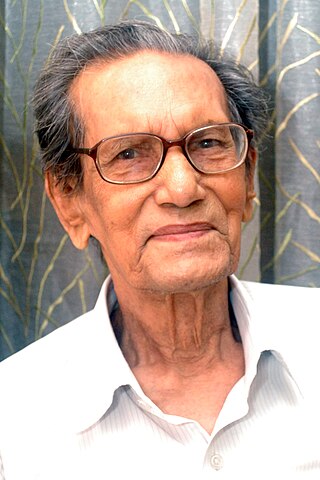Related Research Articles

Assam is a state in northeastern India, south of the eastern Himalayas along the Brahmaputra and Barak River valleys. Assam covers an area of 78,438 km2 (30,285 sq mi). It is the second largest state in northeastern India by area and the largest in terms of population, with more than 31 million inhabitants. The state is bordered by Bhutan and Arunachal Pradesh to the north; Nagaland and Manipur to the east; Meghalaya, Tripura, Mizoram and Bangladesh to the south; and West Bengal to the west via the Siliguri Corridor, a 22-kilometre-wide (14 mi) strip of land that connects the state to the rest of India. Assamese and Bodo are two of the official languages for the entire state and Meitei (Manipuri) is recognised as an additional official language in three districts of Barak Valley and Hojai district. in Hojai district and for the Barak valley region, alongside Bengali, which is also an official language in the Barak Valley.

Dibrugarh district (Pron:ˌdɪbru:ˈgor:) is a district in the state of Assam in India. The district headquarters are located within the city of Dibrugarh.

The Institute for Plasma Research (IPR) is a public research institute in India. The institute conducts research in plasma science, including basic plasma physics, magnetically confined hot plasmas, and plasma technologies for industrial applications. It is the leading plasma physics organization of India and houses the largest tokamak of India - SST1. IPR plays a major scientific and technical role in Indian partnership in the international fusion energy initiative ITER. It is part of the IndiGO consortium for research on gravitational waves. It is an autonomous body funded by the Department of Atomic Energy.

Dibrugarh University is a collegiate public state university in the Indian state of Assam. It is the second oldest University in Assam and in North East India. It is a member of the Association of Indian Universities and Association of Commonwealth Universities. It is located at Dibrugarh, Assam, India. It was set up on 1 July 1965 under the provisions of the Dibrugarh University Act, 1965 enacted by the Assam Legislative Assembly. The University was established to build it as a Center of Science and Technology. As the University was planned as a centre of higher education in science and technology, Bhoj Raj Seth, an eminent mathematician of the Indian Institute of Technology, Kharagpur, was appointed as the first Vice-Chancellor at the initiative of the then Education Minister of Assam, Dev Kant Barooah.

The Department of Atomic Energy (DAE) is an Indian government department with headquarters in Mumbai, Maharashtra, India. DAE was established in 1954 with Jawaharlal Nehru as its first minister and Homi Bhabha as its secretary.

Suhungmung, or Dihingia Roja was one of the most prominent Ahom Kings who ruled at the cusp of Assam's medieval history. His reign broke from the early Ahom rule and established a multi-ethnic polity in his kingdom. Under him the Ahom Kingdom expanded greatly for the first time since Sukaphaa, at the cost of the Chutia and the Dimasa kingdoms. He also successfully defended his kingdom against Muslim invasions, first by a general called Bar Ujjir and another by Turbak Khan. During his time, the Khen dynasty collapsed and the Koch dynasty ascended in the Kamata kingdom. His general, Ton-kham, pursued the Muslims up to the Karatoya river, the western boundary of the erstwhile Kamarupa Kingdom, the farthest west an Ahom military force had ventured in its entire six hundred years of rule.
Assam silk denotes the three major types of indigenous wild silks produced in Assam—golden muga, white pat and warm eri silk. The Assam silk industry, now centered in Sualkuchi, is a labor-intensive industry.

Upper Assam is an administrative division of the state of Assam comprising the undivided Lakhimpur and Sivasagar districts, of the upper reaches of the Brahmaputra valley. The other divisions are: Lower Assam, North Assam and Hills and Barak Valley. The division is under the jurisdiction of a Commissioner, stationed at Jorhat.

Bikash Sinha was an Indian physicist who was active in the fields of nuclear physics and high energy physics. Sinha was the director of the Saha Institute of Nuclear Physics and Variable Energy Cyclotron Centre and the chairman of the Board of Governors of the National Institute of Technology, Durgapur in June 2005. He was also a member of scientific advisory board to the Prime Minister of India.
Betsy Ancker-Johnson was an American plasma physicist. She was known for her research into instabilities that can occur in plasmas in solids, and for her invention of a gigacycle range signal generator using semiconductor materials in magnetic and electric fields. She was the first woman Presidential appointee in the U.S. Department of Commerce. She is the fourth woman elected to the National Academy of Engineering.
Bruno Coppi is an Italian-American physicist specializing in plasma physics.

Jorhat is a major city in Upper Assam and amongst the fastest growing urban centres in the state of Assam in India.

The Chutia people are an ethnic group that are native to Assam and historically associated with the Chutia kingdom. However, after the kingdom was absorbed into the Ahom kingdom in 1523–24, the Chutia population was widely displaced and dispersed in other parts of Upper Assam as well as Central Assam. They constitute one of the core groups that form the Assamese people.

Ramadas Panemangalore Shenoy was an Indian defence scientist and writer, known for his contributions in the field of radar technology. He secured a doctoral degree in electrical engineering from the University of Wisconsin–Madison and joined Defence Research and Development Organization in 1961, involving himself with the indigenous development of radar technology till his retirement, as a Distinguished Scientist, in 1989.
Assam – 16th largest, 15th most populous and 26th most literate state of the 28 states of the democratic Republic of India. Assam is at 14th position in life expectancy and 8th in female-to-male sex ratio. Assam is the 21st most media exposed states in India. The Economy of Assam is largely agriculture based with 69% of the population engaged in it. Growth rate of Assam's income has not kept pace with that of India's during the Post-British Era; differences increased rapidly since the 1970s. While the Indian economy grew at 6 percent per annum over the period of 1981 to 2000, the same of Assam's grew only by 3.3 percent.

Muga silk is a variety of wild silk geographically tagged to the state of Assam in India. The silk is known for its extreme durability and has a natural yellowish-golden tint with a shimmering, glossy texture. It was previously reserved for the use of royalty. Muga is one of the three major types of indigenous wild silks produced in Assam, and is a key variety of Assam silk renowned for its natural golden color and durability.

Jyotiprasad Medhi was a professor of statistics at Gauhati University and Institute of Advanced Study in Science and Technology.
Heremba Bailung is an Indian physicist. He is a professor at and the director of the Institute of Advanced Study in Science and Technology.

Hemoprova Chutia is an Indian handloom weaver and artist based in Dibrugarh, Assam who has crafted a variety of creations using diverse fabrics such as cotton, silk, wool, and intricately cut bamboo. She has received various awards and honours for her contribution in the art, including the Assam Gourav award presented by the Government of Assam in 2022.
References
- ↑ "Indian scientists unearth Assam's Muga silk's wound-healing powers". Zee News. 23 December 2014. Retrieved 26 April 2015.
- ↑ "Indian scientists unearth wound-healing powers of Assam's Muga silk". Gulf News. 23 December 2014. Retrieved 26 April 2015.
- ↑ "Science weds art". Harmony India. Archived from the original on 4 March 2016. Retrieved 26 April 2015.
- ↑ "Zone wise list of Fellows & Honorary Fellows (2015 )" (PDF). National Academy of Sciences. Archived from the original (PDF) on 29 September 2015. Retrieved 18 November 2015.
- ↑ "Women scientists continue to face discrimination'". The Sentinel. Archived from the original on 4 March 2016. Retrieved 18 November 2015.
- ↑ "Indian scientists unearth Muga silks wound-healing powers". Free Press Journal . 21 October 2014. Archived from the original on 19 November 2015. Retrieved 18 November 2015.
- 1 2 3 "My experience with research" (PDF). www.ias.ac.in. Retrieved 26 April 2015.
- 1 2 The girl's guide to a life in science. Ramaswamy, Ram., Godbole, Rohini M., Dubey, Mandakini. New Delhi: Young Zubaan. 2011. ISBN 9789381017111. OCLC 774206856.
{{cite book}}: CS1 maint: others (link) - ↑ "Prof. Joyanti Chutia". www.ewwomen.in. Archived from the original on 19 November 2015. Retrieved 18 November 2015.
- ↑ "INDIA-AUSTRALIA WORKSHOP ON BIOTECHNOLOGY ORGANISED". Report from the Assam Tribune brought to you by HT Syndication Hindustan Times . 22 October 2008. Archived from the original on 20 February 2016. Retrieved 18 November 2015.
- ↑ "KAMAL KUMARI NATIONAL AWARDS PRESENTED". Hindustan Times . 2 April 2006. Archived from the original on 2 November 2012. Retrieved 18 November 2015.
- ↑ "IASST CELEBRATES FOUNDATION DAY". Report from the Assam Tribune brought to you by HT Syndication Hindustan Times. 8 November 2006. Archived from the original on 20 February 2016. Retrieved 18 November 2015.
- ↑ "WORKSHOP ON PLANT DIVERSITY HELD". Report from the Assam Tribune brought to you by HT Syndication Hindustan Times. 23 November 2008. Archived from the original on 20 February 2016. Retrieved 18 November 2015.
- ↑ "Joyanti Chutia | PhD | Institute of Advanced Study in Science and Technology, Guwahati | IASST | Division Physical Sciences". ResearchGate. Retrieved 16 February 2019.
- ↑ "Scientists unearth Assam's Muga silk's wound-healing powers". The Shillong Times. Retrieved 16 February 2019.
- ↑ "Can Indian Silk Promote Wound Healing?". Advanced Tissue. 23 January 2015. Archived from the original on 16 February 2019. Retrieved 16 February 2019.